This is here for interest only now – User Types 2.0 is where it is a now!!
Last week I started to explore my ideas about the different types of users there are likely to be in a gamified system. I have had loads of feedback, mostly very positive. Thanks for that. One question that keeps coming up is “what about the Player user type”? “There must be more too it!”. The answer is, of course, yes. There is a lot more.
What I explored last week was really just the intrinsically motivated types of users. Those doing things for purely self related reasons. Helping others, because it makes them feel good. Learning because they want to and enjoy the experience. Creating content that they feel will add to the greater meaning of a system.
The player type of user was there to describe the idea that there are those for whom the intrinsic value of an activity is far less important than the reward that they can get from doing the activity.
What’s in a word?
In theory, you could settle for calling them; Player Achiever, Player Socialiser, Player Free Spirit and Player Philanthropists – believe me, I wish I had! However, as with all good systems, it helps to have names you can visualise and connect with behaviours. So, I propose the following. Oh and I can’t stress enough – this is not a theory, this is a categorisation. It is also not the same as Bartle’s Player Types, because we are not looking at real games.
8 User Types
This leaves us with 8 user types, 4 intrinsically motivate and 4 primarily extrinsically motivated. The next step for my categorisation is to look at what these 8 types are acting on in out gamified system. Bartle’s original axes help here. They describe whether a player is interacting with or acting on people or the virtual world. This gives us 2 diagrams to help visualise this. The first describes the intrinsically motivated users, the second the extrinsically motivated.
- Philanthropists Act on Users for Intrinsic Reasons
- For example, people who answer questions on forums or edit entries on Wikipedia.
- Achievers Act on the System for Intrinsic Reasons
- People who will learn from the system, just because they enjoy it. Those who will wish to perfect task, just because they want to. May also be motivated by status as a representation of their personal achievement
- Socialisers Interact with Users for Intrinsic Reasons
- Those people who just like to talk to others and enjoy being connected to people
- Free Spirits Interact with System for Intrinsic Reasons
- Those looking to enjoy the self expression a system may afford them. May also be explorers. Want to get the most from a system, because they enjoy it
- Self Seekers Act on Users for Extrinsic Reward
- They will answer questions and help others, but purely to get rewards and visible status from the system. Quantity over quality – unless quality gets them more rewards. They are uninterested in the social aspect of users
- Consumers Act on the System for Extrinsic Reward
- A consumer wants to use a system that can give them something. An example would be people who use one particular airway because of the loyalty scheme.
- Networkers Interact with Users for Extrinsic Reward
- They want social connections, but to give them some form of status or reward. An example of this are people who network and tweet etc. just to get higher Klout scores
- Exploiters Interact with the System for Extrinsic Reward
- Similar in nature to Self Seekers, they are the people who will like or upvote or retweet something multiple times to gain reward. Unlike Free Spirits, who will seek the boundaries of a systems capabilities for fun, they are very likely to find the loopholes in your rules and exploit them
As you can see, within the Player User types there may well be some cross over of motivation. Consumers and Exploiters may share many of the same traits. The difference is, exploiters will try to find the boundaries of the system and how that may benefit them – consumers just want to get their reward with as little action from them as possible.
Possible Interactions
All of these different user types have the potential to affect each other in your system.
For example, Philanthropists are the parent figure. They are the ones who are likely to want to help anybody they can, no matter of the other persons motives. Exploiters, on the other hand, will make use of anyone and everything they can to get personal gain from the system.
Socialiser and Networkers will wish to interact with anyone. Neither will be after anything from people directly. In the case of a networker, their reward comes from being connected, where as the socialiser’s reward is knowing you and interacting with you.
Self Seekers have no real interest in in the people within a system, they are just a means to an end (that end being the shiny shiny things). In a similar way, Achievers are not there for the people, they are there for self enrichment. The big difference here is that the Self Seeker is the one who will collect badges and trophies in a system to show off their expertise to others. The Self Seeker is very similar to the Bartle Achiever player type!
Free Spirits and Consumers have the least impact on any of the other users. Their interests are purely personal, using the system to get what they want from it. Other users are of no direct interest to them.
Putting it together visually
I could call this, making a pretty picture that looks like Bartle’s full 8 Player Type model!
All of this can be represented in a sort of ‘3D’ / TriDimensional version of our two Acting On diagrams from earlier.
How do you create a balanced system for all types of users?
The answer is, with great difficulty and it depends on the goals of your system. However, if you go back to when we just had five user types, Player and then Philanthropists, Socialisers, Achievers and Free Spirits, it becomes a little clearer.
Create a system that appeals to the four basic intrinsic motivations and user types. Make it social, make it meaningful and give people some freedom. Then, integrate a well thought out reward system (points, badges etc.). If you do it this way around, you are not creating a system that relies on the rewards to run. That way, you get the intrinsically motivated people anyway and those that are there for rewards are catered for.
Next, looking a little deeper, the eight types of users can help us decide how to balance the system. It is important to keep in mind that you want more of the intrinsically motivated users if possible. These are the ones who will keep coming back, keep producing content or whatever else they are meant to be doing.
If the system is flooded with Self Seekers and Exploiters then you stand the chance of devaluing everything. Self Seekers run the risk of generating lots of meaningless content whilst exploiters will reduce the value of things like upvotes and likes if the rewards are badly implemented.
Philanthropists and Achievers can both help a system thrive. Philanthropists want to help everyone. They want to answer questions and guide users. Achievers, depending on the type of system, may also wish to do the same. They are interested in being the best – at mastering things. They will want to give the best answer to a question, not so much to help the user, but to know they were the best. However, as their main aim is self-enrichment, they can also give very little back to as system aimed at teaching – which may be just what you want!
Free Spirits and Consumers tend to give very little back to the people, consumers especially. Too many of either of them and the social aspect of your system stands a good chance of not working. It is possible that consumers are all you want (with a loyalty scheme), but it is worth considering you can get greater value from engaging everyone else.
Socialisers are great for evangelising a system and bringing more people too it, however, they don’t add content to systems as much as other types. Networkers are similar, whatever their motivations may be. However, networkers will bring in anyone, not just relevant people. Too many of them and the social aspect of the system can become diluted. Look at users on twitter with 30,000 “friends” then look at what content these friends actually generate. The likelihood is that of these 30,000 people, they only interact with a tiny fraction – so will other users.
Also (to satisfy a question I have had), exploiters are the most likely to “cheat”. Now, cheating is different things to different people. In this case, I mean they are the ones who will “exploit” loopholes in the rules to gain – even if it is at the expense of others within the system.
It is really important to keep in mind, these are all just and seconded to help clarify thinking. Real life is not as black an white, users will most likely display traits from multiple user types. But, they will usually have one that guides them more than the others.
Thanks for all the feedback and I hope I get loads more. This is not a finished product in my mind and I will probably revisit it in the future. I hope you find it of use and that it makes defining your systems a little easier.
Why not take the User Type Test and see which of the 4 basic types you may be?
Similar Posts:
- Where is the Killer / Winner Type in your HEXAD?
- Using the Gamification User Types in the Real World
- User Types Test: Stats and conclusions
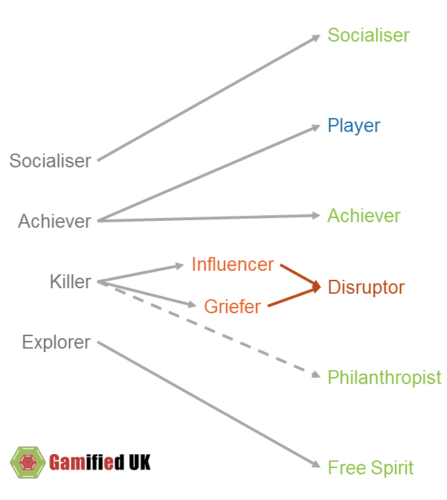
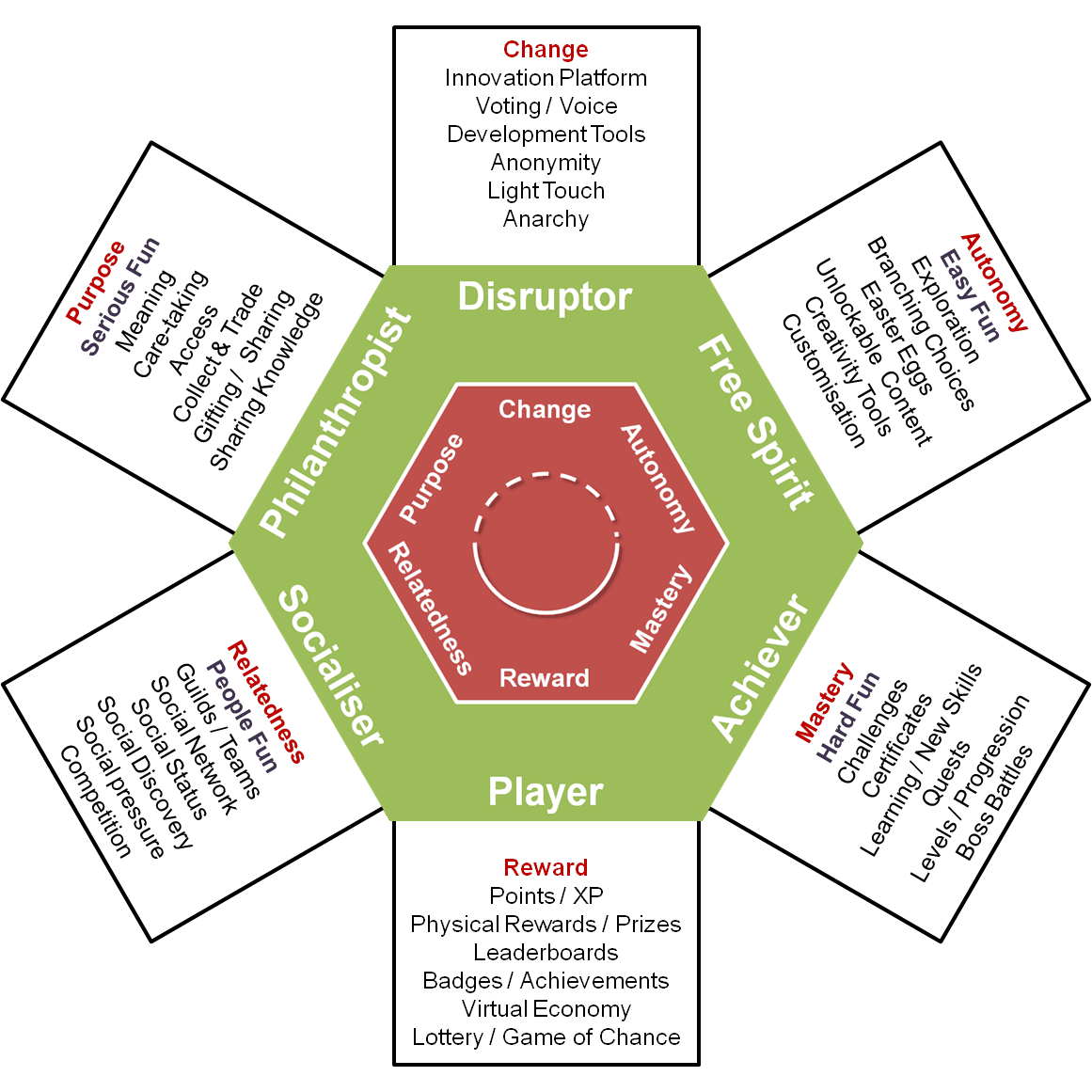
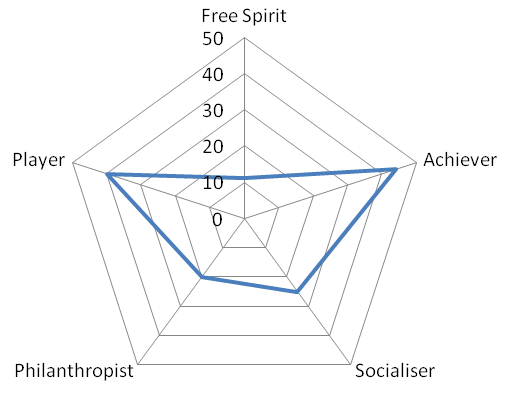

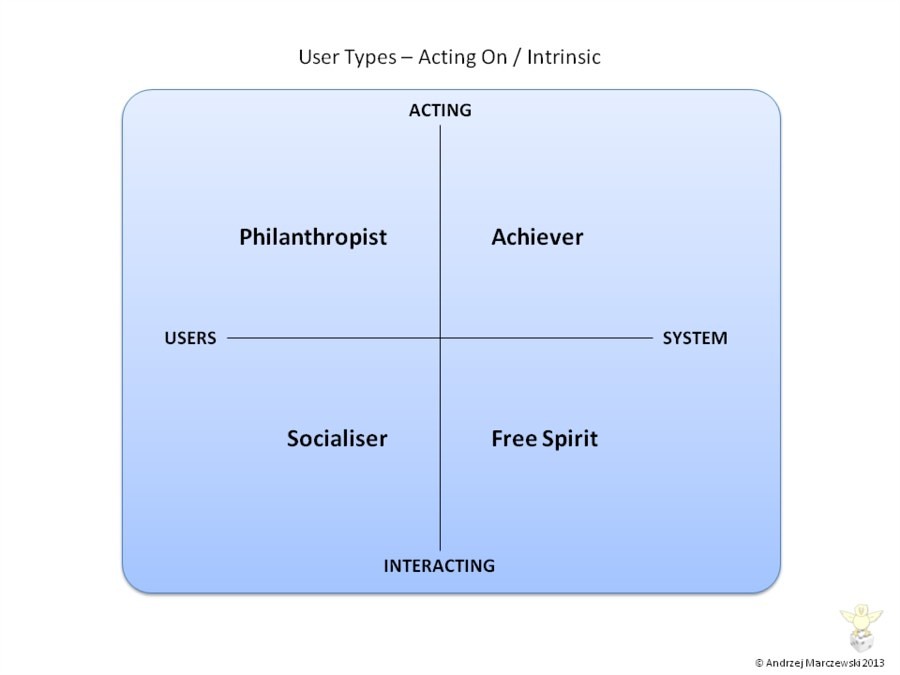
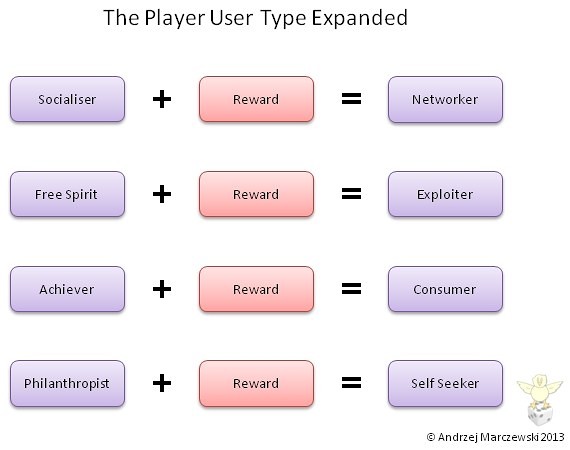



I realized a bit belatedly that my previous response did not adequately express what I was trying to say.
Let’s use the old standby of airline rewards for an example.
One might say that people are motivated by the points, or the extra miles, being the first in line, all of which are extrinsic rewards given out by the airline for following a set behavior path. However, that is not exactly an accurate depiction of what is happening.
The motivation for these things has nothing to do with the points, or the line, or the miles. The motivators are deeper than that, and simpler. Comfort, social standing, economics, the desire to explore, etc. Each of these things has an associate intrinsic reward. When you are comfortable, you feel better physically. When you are respected or admired, it feels good and boosts your self-esteem/ego. When you save money, you are able to do more with what you have, including meeting both your needs and your wants, which makes you feel more successful along with whatever perks come from where you choose to spend your money.
There is no such thing as an extrinsic motivation. In gamification, our goal should be to first off understand those intrinsic motivations, and then to help our clients meet those underlying needs in a way that is beneficial to the client and their customer. The extrinsic rewards are just fluff that hide the real meaty goodness. What’s worse is that they tend to desensitize people to the intrinsic rewards.
Again, not disagreeing with any of that. This classification still does nothing to undermine that.
Approve.
Andrzej Marczewski
Sent from my mobile device
The use of the word motivation is a convenience here. Of course, money is not a direct motivator it is a means to achieve a more comfortable life or a higher status. But not many people understand that. This is meant to try and simplify the process of understanding people in a Gamified system. Those people who just want to win by any means possible. Those who collect points with no real interest in the meaning behind them. They exist and need to be handled.
I think that while these classifications in general are good, but I disagree (and always have to an extent) with the classification of rewards as intrinsic and extrinsic when what you are really talking about is whether the motivation is intrinsic or extrinsic. A reward should always be intrinsic to an action, that is how we maintain continuity within a system. When extrinsic rewards are applied, or rewards that forced from an external source, it is always disruptive because it either masks or disrupts the intrinsic reward.
Instead of focusing on a reward first approach, think from a motivator first perspective. All motivation is intrinsic, even when affected by outside influences. For example, if someone puts a gun to your head and tells you to do something that it is against your nature, it is not the gun making you do it, it is the fear of death, which is intrinsic.
Even when looking at extrinsic rewards, you should be asking what the intrinsic reward for acquiring them is. There is always a reward that is purely internal that is being fulfilled. These rewards are usually very low level. For example, the networker and socialize are both fulfilling the same underlying needs met by interpersonal relationships, and getting the same intrinsic rewards. If anything, the biggest difference between the two is that the networker has been desensitized to intrinsic rewards.
If you want to get deep into profiling people, you should be looking at young children, not adults. They tend to have less deeply ingrained learned behaviors and demonstrate more raw personality. Their motivation is also more readily transparent, and most often in its simplest form. Even though those of us involved in gamification are primarily dealing with adults, most people never outgrow their innate childhood tendencies.
All of this is not to say that anything you have posted is wrong. Just that focusing on or catering to the extrinsic rewards has longterm negative consequences. Essentially, you are positively reinforcing extreme selfish behaviors that intentionally abuse an otherwise healthy system, whether it be by creating a fraudulent level of +1’s/likes/social status, abusing interpersonal relationships, or taking money.
I don’t disagree with any of that and I have writing about motivation and the negative impact of rewards in great detail in other posts. This classification is more to help people move away from focusing on Bartles player types and start looking at what really happens in non game situations.
Also this is looking at what motivates certain types as well, concentrating on autonomy, mastery, purpose, relatedness Eric. The second part is how to cater for those who are motivated by extrinsics. They both exist and they both have to be considered – even if the extrinsic reward is just there to help with getting people onboard and is eased off as the user gets more intrinsically motivated by the system.
I would never advocate a system that just relied on points and badges as a way of “motivating” people. It will never work for any length of time.
Andrzej Marczewski
Sent from my mobile device
I like the distinction between player types by their intrinsic/extrinsic motivation. Great post, Andrzej.
We know that it could be dangerous to provide extrinsic rewards to someone who is already intrinsic motivated. So, now it would be interesting to see if there are particular extrinsic rewards that fit to the adequate intrinsic motivated player types. And if yes, then what if we avoid exactly these extrinisic rewards but could try to use these extrinsic rewards that match rather with the less developed intrinsic player types of the player.
This way we would avoid to destroy the intrinsic motivation of the most distinctive player type and, at the same time, enhance motivation for activities where the player is less motivated.
What do you think?
Thanks @romrack:disqus That is an intersting idea. I was playing with the idea of what may be usable to motivate these users, something like the image here. I struggle with status though, i feel it has both intrinsic and extrinsic features. My achiever would like status, but only as a way to measure themselves. The Self Seeker would use status as a way of showing off.
This foundation makes some sense to me. I am interested in getting it applied to my new mobile product. Let’s keep in touch.
Definitely, thanks!